Transboundary Water–Energy–Food Nexus Management in Major Rivers of the Aral Sea Basin Through System Dynamics Modelling
Abstract
1. Introduction
2. Materials and Methods
2.1. Study Area: Aral Sea Basin
2.2. SD Modelling
- Feedback mechanisms: Identification of reinforcing and balancing loops that drive system behaviour.
- Stock-and-flow representation: Visualization of water reservoirs, energy outputs, and agricultural production.
- Time delays: Consideration of lag effects in policy implementation and resource availability.
- Integrated scenario analysis: Simulation of different SSPs combined with RCPs interventions to evaluate their long-term impacts on resource sustainability [43].
2.3. Software for SD Modelling
2.4. Design of the WEF Nexus SDM
- Water: Assesses the availability and consumption of water, considering its distribution for HP generation. It also accounts for other competing demands, including urban, industrial, and agricultural needs.
- Energy: Concentrates on renewable energy development. The model analyses the transition from fossil fuels to RES, ensuring that energy requirements are met while maintaining environmental sustainability.
- Food: Analyzes water usage in food production and incorporates it into the overall water management framework. It also evaluates irrigation techniques, agricultural policies, and compromises required to balance water demands.
2.4.1. System Boundaries, Scope, and Spatial Relation
2.4.2. Conceptual Model, Key Variables, and Stock-and-Flow Variables
2.4.3. Interlinkages Between Subsystems
2.4.4. Transboundary Effects
2.5. Development of the WEF Nexus SDM
2.5.1. Data Collection and Processing
- Area-based downscaling: National-level data are proportionally distributed according to the relative area of each sub-basin (SB). This approach is applied to downscale total final consumption (TFC) for non-specified uses, thermal energy production (TEP) from renewable energy sources not included in GIS databases, and fossil energy sources, among others.
- Population-based downscaling: Resources are allocated in proportion to the population density within each SB. This method is used, for example, to downscale TFC for the commercial and public services sectors, industrial energy use, urban water demand, and industrial water consumption.
- Land use-based downscaling: Allocation is based on the extent of cropland, irrigated areas, or flood-prone regions within each SB. This method is applied to estimate the energy consumption of agricultural activities, particularly for irrigation systems powered by pumping.
- HP capacity-based downscaling: Distribution considers the available and remaining hydropower capacity at the SB level. For instance, GIS data are used to disaggregate IEA hydropower figures and validate them against values derived through geospatial analysis.
- Method 1: Forward Validation. Starting from national-level data, a proportional value is calculated for each sub-basin (SB). These values are then compared with those generated by the downscaling algorithms. If the results are consistent or the deviations are minimal, the data are considered valid. Otherwise, the downscaling procedure is repeated using an alternative method. This forward validation approach has been applied to verify the water discharge to the Aral Sea and the energy balance presented in Section 3.2.
- Method 2: Reverse Validation. This method involves re-aggregating the downscaled SB-level data back to the national scale and comparing the results with the original national-level figures. If significant discrepancies are found, the downscaling method is re-evaluated and adjusted as needed. This reverse validation approach has been used to calibrate the two key variables discussed in Section 3.2: water discharge to the Aral Sea and the energy balance.
2.5.2. Model Subscripts to Assess the Transboundary Issue of the Resources
2.5.3. Integration of Integrated SSP/RCP Scenarios
3. Results
3.1. WEF Nexus SDM
3.1.1. Water Subsystem
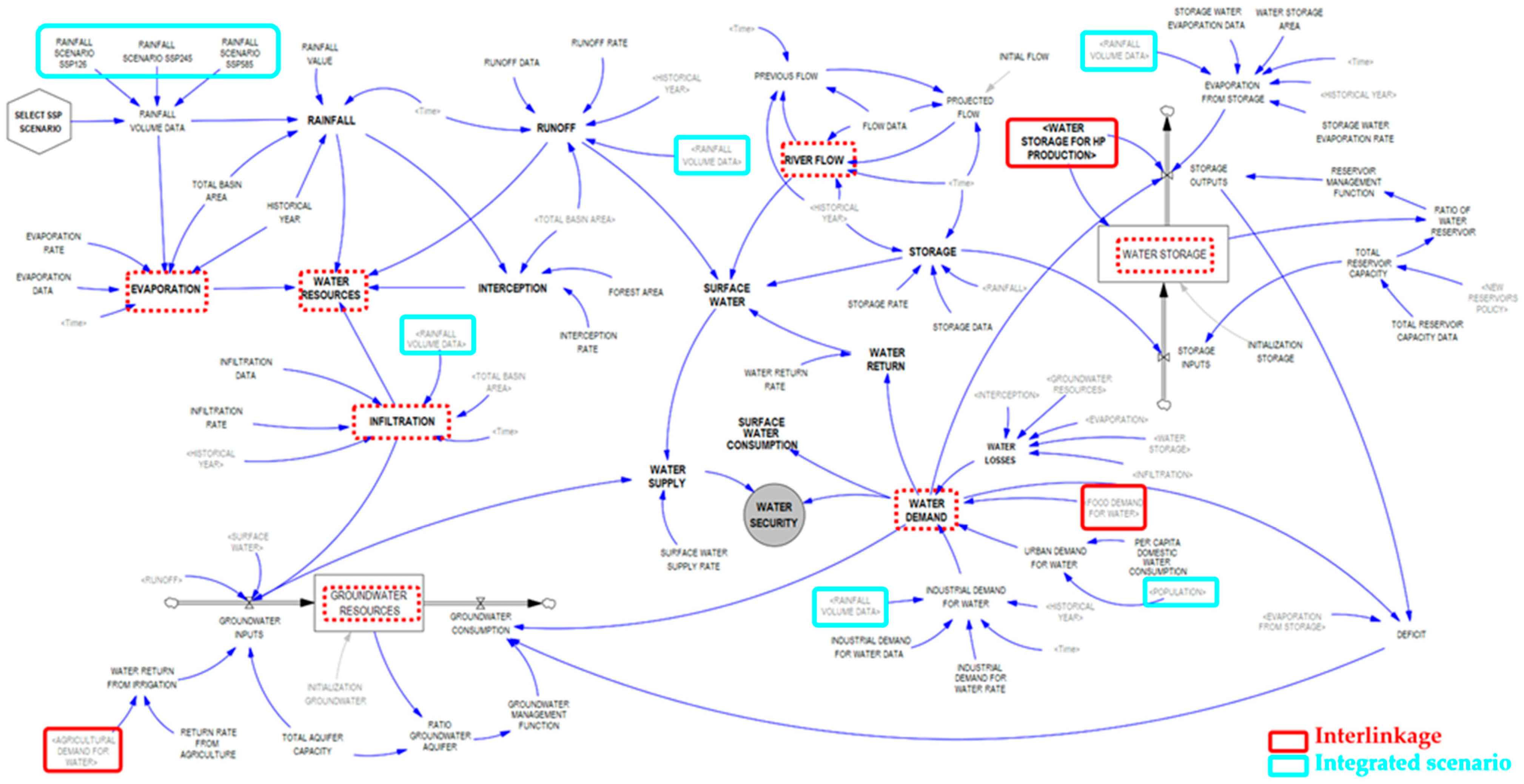
3.1.2. Transboundary Assessment
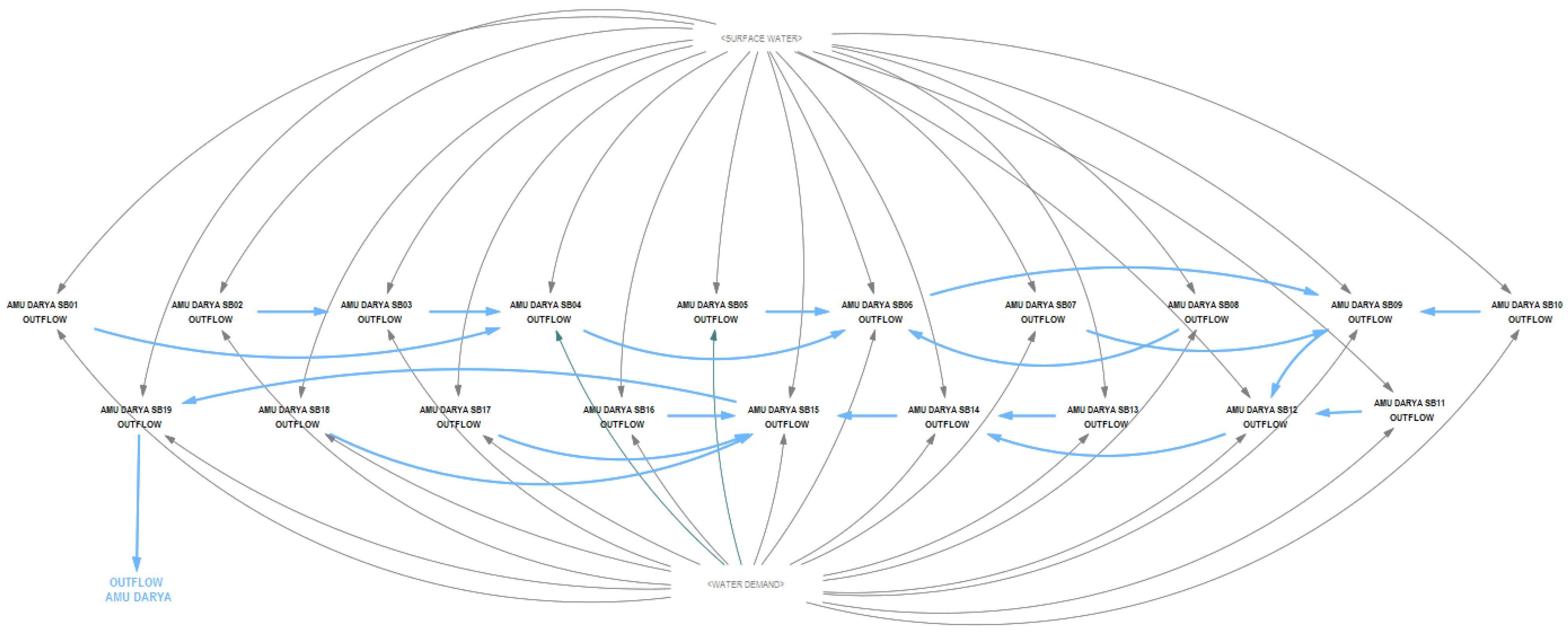

3.1.3. Energy Subsystem

3.1.4. Food Subsystem
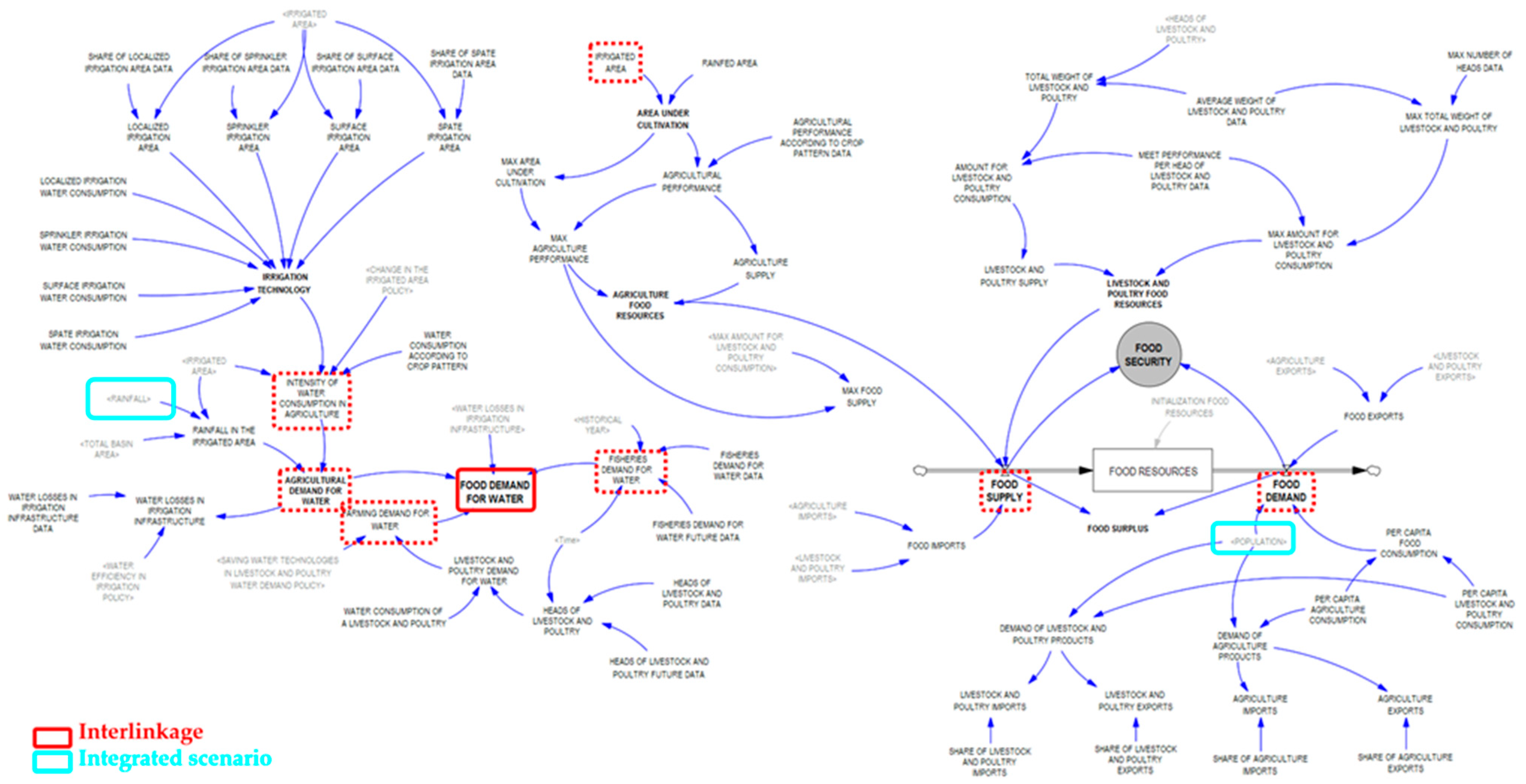
3.2. Model Calibration and Validation
3.2.1. Water Discharge to the Aral Sea
3.2.2. Energy Balance
3.2.3. Agricultural Demand for Water
4. Discussion
4.1. Future Trends in the Amu Darya and Syr Darya Discharges to the Aral Sea
4.2. Future Trends in WEF Security at the SB Level
Energy Security in Syr Darya River Basin
4.3. Integrated Policy and Technical Recommendations for Sustainable WEF Nexus Management in the Aral Sea Basin
- Modernize water efficiency in irrigation: Outdated irrigation infrastructure, especially in the Fergana Valley, leads to significant water and energy losses, up to 15% of energy input. Upgrading to modern systems (e.g., drip, sprinkler, efficient pumps) is essential to reduce water stress and improve agricultural efficiency. Regional cooperation among Uzbekistan, Kazakhstan, and Kyrgyzstan is recommended for infrastructure upgrades and knowledge exchange [87].
- Sustainability harnesses HP potential: Kyrgyzstan and Tajikistan rely heavily on HP, yet vast HP and SHP resources remain untapped. UNIDO estimates an additional 33 GW potential, mostly in Tajikistan. Sustainable HP development, respecting ecological flows (as integrated in the model), should be prioritized [88].
- Invest in diverse renewables for energy security: The Syr Darya basin suffers from energy insecurity due to HP dependence and climate sensitivity. Countries like Kyrgyzstan and Kazakhstan should expand solar, wind, and other renewables to diversify energy sources. Though the Amu Darya basin is more stable, renewable energy investment is also needed there for decarbonization. Model scenarios support this transition for reducing emissions and increasing system resilience across the ASB.
- Shift to sustainable crops: Excessive cotton cultivation, especially during the Soviet “Aral Sea Plan”, caused major water depletion [89]. Replacing cotton with less water-intensive, climate-resilient crops like wheat or maize can improve sustainability. Kazakhstan’s grain-based agriculture shows this is feasible. All ASB countries should promote crop diversification and adopt efficient farming practices to protect water resources and ensure long-term food security [90].
5. Conclusions
Author Contributions
Funding
Data Availability Statement
Acknowledgments
Conflicts of Interest
Abbreviations
| AD | Amu Darya |
| ASB | Aral Sea Basin |
| CA | Central Asia |
| CCS | Carbon Capture and Storage |
| Dmnl | Dimensionless |
| GHG | Greenhouse Gas |
| GIS | Geographic Information System |
| GWh | Gigawatt hour |
| hm3 | Cubic hectometres |
| HP | Hydropower |
| km | Kilometres |
| KPI | Key Performance Indicator |
| QGIS | Quantum Geographic Information System |
| MAE | Mean Absolute Error |
| RCP | Representative Concentration Pathways |
| RES | Renewable Energy Sources |
| SB | Sub-basin |
| SD | Syr Darya |
| SDG | Sustainable Development Goals |
| SDM | System Dynamics Model |
| SHP | Small Hydropower |
| SSP | Shared Socioeconomic Pathways |
| TEP | Total Energy Production |
| TES | Total Energy Supply |
| TFC | Total Final Consumption |
| ton | Tonnes |
| WEF | Water-Energy-Food Nexus |
Appendix A. Main Mathematical Relationships
Appendix A.1. Water Subsystem
Appendix A.2. Energy Subsystem
Appendix A.3. Food Subsystem
References
- Varis, O.; Kummu, M. The Major Central Asian River Basins: An Assessment of Vulnerability. Int. J. Water Resour. 2012, 28, 433–452. [Google Scholar] [CrossRef]
- Bank, E.D. Regulation of the Water and Energy Complex of Central Asia Reports and Working Papers 22/4. Available online: https://eabr.org/upload/iblock/43a/EDB_2022_Report-4_Water-and-Energy-Complex-of-CA_eng.pdf (accessed on 9 April 2025).
- Zhang, M.; Chen, Y.; Shen, Y.; Li, B. Tracking climate change in Central Asia through temperature and precipitation extremes. J. Geogr. Sci. 2019, 29, 3–28. [Google Scholar] [CrossRef]
- Touge, Y.; Kobayashi, G.; Khujanazarov, T.; Tanaka, K. Reproduction of historical water balance in the Aral Sea Basin: The physically-based framework to quantify water consumption components in endorheic lake. J. Hydrol. 2024, 640, 131711. [Google Scholar] [CrossRef]
- Şamlı, E. Problems of Water Management in Post-Soviet Central Asia. Mater’s Thesis, Social Sciences of Middle East Technical Univesity, Ankara, Turkey, 2017. [Google Scholar]
- The Aral Sea Crisis: Environmental Impacts. Available online: https://www.columbia.edu/~tmt2120/environmental%20impacts.htm (accessed on 27 March 2025).
- Qi, J.; Evered, K.T. Environmental Problems of Central Asia and Their Economic, Social and Security Impacts. 2008. Available online: https://pdfs.semanticscholar.org/092c/f0b4233124d3d6da72543220fbe658075692.pdf (accessed on 28 March 2025).
- Wang, X.; Zhang, J.; Wang, S.; Ge, Y.; Duan, Z.; Sun, L.; Meadows, M.E.; Luo, Y.; Fu, B.; Chen, X.; et al. Reviving the Aral Sea: A hydro-eco-social perspective. Adv. Earth Space Sci. 2023, 11, e2023EF003657. [Google Scholar] [CrossRef]
- Janobiddinov, A. The Shrinking of the Aral Sea: A Cascading Environmental Disaster. 2024. Available online: https://www.geopoliticalmonitor.com/shrinking-aral-sea-an-invisible-environmental-crisis/ (accessed on 28 March 2025).
- Ganguly, A. The Future of Water Management in Central Asia. 2014. Available online: https://www.idsa.in/wp-content/uploads/2024/05/IB-Anusua-Ganguly-02-May-2024.pdf (accessed on 27 March 2025).
- Anchita; Zhupankhan, A.; Khaibullina, Z.; Kabiyev, Y.; Persson, K.M.; Tussupova, K. Health impact of drying Aral Sea: One health and socio-economical approach. Water 2021, 13, 3196. [Google Scholar] [CrossRef]
- Saidmamatov, O.; Rudenko, I.; Pfister, S.; Koziel, J. Water-energy-food nexus framework for promoting regional integration in Central Asia. Water 2020, 12, 1896. [Google Scholar] [CrossRef]
- Mayar, M.A.; Hamidov, A.; Akramkhanov, A.; Helming, K. Consideration of the environment in water-energy-food nexus research in the Aral Sea Basin. Water 2024, 16, 658. [Google Scholar] [CrossRef]
- Kaddoura, S.; Khatib, S.E. Review of water-energy-food nexus tools to improve the nexus modelling approach for integrated policy making. Environ. Sci. Policy 2017, 77, 114–121. [Google Scholar] [CrossRef]
- Dankova, R.; Burton, M.; Salman, M.; Clark, A.K.; Pek, E. Modernizing Irrigation in Central Asia: Concept and Approaches; Directions in Investment; FAO: Rome, Italy, 2022. [Google Scholar]
- Granit, J.; Jägerskog, A.; Lindström, A.; Björklund, G.; Bullock, A.; Löfgren, R.; de Gooijer, G.; Pettigrew, S. Regional Options for Addressing the Water, Energy and Food Nexus in Central Asia and the Aral Sea Basin. Int. J. Water Resour. Dev. 2012, 28, 419–432. [Google Scholar] [CrossRef]
- Bernauer, T.; Siegfried, T. Climate change and international water conflict in Central Asia. J. Peace Res. 2012, 49, 227–239. Available online: https://journals.sagepub.com/doi/abs/10.1177/0022343311425843 (accessed on 13 June 2025). [CrossRef]
- Jalilov, S.-M.; Keskinen, M.; Varis, O.; Amer, S.; Ward, F.A. Managing the water-energy-food nexus: Gains and losses form new water development in Amu Darya river basin. J. Hydrol. 2016, 539, 648–661. [Google Scholar] [CrossRef]
- Jalilov, S.M.; Amer, S.A.; Ward, F.A. Water, food, and energy security: An exclusive search for balance in Central Asia. Water Resour. Manag. 2013, 27, 3959–3979. [Google Scholar] [CrossRef]
- Jalilov, S.-M.; Amer, S.A.; Ward, F.A. Managing the water-energy-food nexus: Opportunities in Central Asia. J. Hydrol. 2018, 557, 407–425. [Google Scholar] [CrossRef]
- Keskinen, M.; Guillaume, J.H.A.; Kattelus, M.; Porkka, M.; Räsänen, T.A.; Varis, O. The Water-Energy-Food nexus and the trans-boundary context: Insights from large Asian rivers. Water 2016, 8, 193. [Google Scholar] [CrossRef]
- González-Rosell, A.; Blanco, M.; Arfa, I. Integrating stakeholder views and system dynamics to assess the Water-Energy-Food Nexus in Andalusia. Water 2020, 12, 3172. [Google Scholar] [CrossRef]
- Wang, X.; Dong, Z.; Sušnik, J. System dynamics modelling to simulate regional water-energy-food nexus combined with the society-economy-environment system in Hunan Province, China. Sci. Total Environ. 2023, 863, 160993. [Google Scholar] [CrossRef]
- Keyhanpour, M.J.; Jahromi, S.H.M.; Ebrahimi, H. System dynamics model of sustainable water resources management using the nexus water-food-energy approach. Ain Shams Eng. J. 2021, 12, 1267–1281. [Google Scholar] [CrossRef]
- Bakhshianlamouki, E.; Masia, S.; Karimi, P.; van der Zaag, P.; Sušnik, J. A system dynamics model to quantify the impacts of restoration measures on the water-energy-food nexus in the Urmia lake Basin, Iran. Sci. Total Environ. 2020, 708, 134874. [Google Scholar] [CrossRef]
- Zahedi, R.; Yousefi, H.; Aslani, A.; Ahmadi, R. Sustainable dynamic planning and policy implementation for water, energy and food resources. Energy Strategy Rev. 2024, 54, 101455. [Google Scholar] [CrossRef]
- Mostefaoui, L.; Sušnik, J.; Masia, S.; Jewitt, G. A water-energy-food nexus analysis of the impact of desalination and irrigated agriculture expansion in the Ain Temouchent region, Algeria. Environ. Dev. Sustain. 2024. [Google Scholar] [CrossRef]
- Javan, K.; Altaee, A.; Darestani, M.; Mirabi, M.; Azadmanesh, F.; Zhou, J.L.; Hosseini, H. Assessing the Water-Energy-Food nexus and resource sustainability in the Ardabil Plain: A system dynamics and HWA approach. Water 2023, 15, 3673. [Google Scholar] [CrossRef]
- Francisco, É.C.; Ignácio, P.S.d.A.; Piolli, A.L.; Poz, M.E.S.d. Food-energy-water (FEW) nexus: Sustainable food production governance through system dynamics modelling. J. Clean. Prod. 2023, 386, 135825. [Google Scholar] [CrossRef]
- Ravar, Z.; Zahraie, B.; Sharifinejad, A.; Gozini, H.; Jafari, S. System dynamics modeling for assessment of water-food-energy resources security and nexys in Gavkhuni basin in Iran. Ecol. Indic. 2020, 108, 105682. [Google Scholar] [CrossRef]
- Ling, M.; Qi, T.; Li, W.; Yu, L.; Xia, Q. Simulating and predicting the development trends of the water-energy-food-ecology system in Henan Province, China. Ecol. Indic. 2024, 158, 111513. [Google Scholar] [CrossRef]
- Feng, M.; Liu, P.; Li, Z.; Zhang, J.; Liu, D.; Xiong, L. Modeling the nexus across water supply, power generation and environment systems using the system dynamics approach: Hehuang Region, China. J. Hydrol. 2016, 543, 344–359. [Google Scholar] [CrossRef]
- White, K.D. Nature and Economy in the Aral Sea Basin. In The Aral Sea; Springer: Berlin/Heidelberg, Germany, 2014; Volume 10178, pp. 301–335. [Google Scholar]
- HydroSHEDS. Available online: https://www.hydrosheds.org/ (accessed on 2 April 2025).
- Wang, X.; Meng, X.; Long, Y. Projecting 1 km-grid population distributions from 2020 to 2100 globally under shared socioeconomic pathways. Sci. Data 2022, 9, 563. [Google Scholar] [CrossRef]
- Service CCC. CMIP6 Climate Projections. 2020. Available online: https://www.wdc-climate.de/ui (accessed on 12 June 2025).
- (FAO) FaAOOotUN. AQUASTAT Rop Water Information. Available online: https://www.fao.org/land-water/databases-and-software/crop-information (accessed on 2 April 2025).
- IEA. International Energy Agency. Available online: https://www.iea.org/ (accessed on 3 April 2025).
- GEO. Global Energy Observatory. 2018. Available online: https://globalenergyobservatory.org/list.php?db=PowerPlants&type=Hydro (accessed on 3 April 2025).
- De Keyser, J.; Fuentes, P.O.; Hayes, D.S.; Habersack, H. A Review of Hydropower in Central Asia: Past, Present, and Future. Renew. Sustain. Energy 2025. in review. [Google Scholar]
- MapSPAM. Mapspam Data Center. 2020. Available online: https://www.mapspam.info/data/ (accessed on 15 April 2025).
- De Keyser, J.; Hayes, D.S.; Marti, B.; Siegfried, T.; Seliger, C.; Schwedhelm, H.; Anarbekov, O.; Gafurov, Z.; López Fernández, R.M.; Ramos Diez, I.; et al. Integrating open-source datasets to analyze the transboundary water-food-energy-climate nexus in Central Asia. Water 2023, 15, 3482. [Google Scholar] [CrossRef]
- Walters, J.P.; Archer, D.W.; Sassenrathc, G.F.; Hendricksond, J.R.; Hansond, J.D.; Hallorane, J.M.; Vadas, P.; Alarcon, V.J. Exploring agricultural production systems and their fundamental components with system dynamics modelling. Ecol. Model. 2016, 333, 51–65. [Google Scholar] [CrossRef]
- Vensim. Ventana System. 2024. Available online: https://vensim.com/ (accessed on 30 May 2025).
- Vensim Software. Available online: https://vensim.com/software/ (accessed on 31 May 2025).
- Pourfallah, H.; Moshtagh, R.; Mastouri, R.M. Water resources modelling using system dynamic in Vensim. J. Water Resour. Hydraul. Enfineering 2015, 4, 251–256. [Google Scholar]
- Jones, L. Vensim and the development of system dynamics. In Discrete-Event Simulation and System Dynamics for Management Decision Making; Wiley: Hoboken, NJ, USA, 2014. [Google Scholar] [CrossRef]
- Peña-Torres, D.; Boix, M.; Montastruc, L. Multi-objective optimization and demand variation analysis on a water energy food nexus system. Comput. Chem. Eng. 2024, 180, 108473. [Google Scholar] [CrossRef]
- Albrecht, T.R.; Crootof, A.; Scott1, C.A. The water-energy-food nexus: A systematic review of methods for nexus assessment. Environ. Res. Lett. 2018, 13, 043002. [Google Scholar] [CrossRef]
- UNECE. Handbook on Water Allocation in a Transboundary Context. 2021. Available online: https://unece.org/sites/default/files/2021-12/ECE_MP.WAT_64_Handbook%20on%20water%20allocation%20in%20a%20the%20transboundary%20context.pdf (accessed on 12 June 2025).
- UNECE, Organizations INoB. Water and Climate Change Adaptation in Transboundary Basins: Lessons Learned and Good Practices. 2015. Available online: https://www.gwp.org/globalassets/global/toolbox/references/adaptation-in-transboundary-basins.pdf (accessed on 12 June 2025).
- Tebaldi, C.; Debeire, K.; Eyring, V.; Fischer, E.; Fyfe, J.; Friedlingstein, P.; Knutti, R.; Lowe, J.; O’NEill, B.; Sanderson, B.; et al. Climate model projections from the Scenario Model Intercomparasion Project (ScenarioMIP) of CMIP6. Earth Syst. Dyn. 2021, 12, 253–293. [Google Scholar] [CrossRef]
- Farjad, B.; Gaputa, A.; Sartipizadeh, H.; Cannon, A.J. A novel approach for selecting extreme climate change scenarios for climate change impact studies. Sci. Total Environ. 2019, 678, 476–485. [Google Scholar] [CrossRef]
- NGFS. Guide to Climate Scenario Analysis for Central Banks and Supervisors. 2020. Available online: https://www.ngfs.net/system/files/import/ngfs/medias/documents/ngfs_guide_scenario_analysis_final.pdf (accessed on 15 May 2025).
- IPCC. Future Global Climate: Scenario-Based Projections and Near-Term Information. 2021. Available online: https://www.ipcc.ch/report/ar6/wg1/downloads/report/IPCC_AR6_WGI_Chapter04.pdf (accessed on 14 May 2025).
- Vogel, R.M.; Lall, U.; Cai, X.; Rajagopalan, B.; Weiskel, P.K.; Hooper, R.P.; Matalas, N.C. Hydrology: The interdisciplinary science of water. Water Resour. Res. 2015, 51, 4409–4430. [Google Scholar] [CrossRef]
- FAO. Climate-Smart Agriculture Sourcebook. 2013. Available online: https://openknowledge.fao.org/server/api/core/bitstreams/b21f2087-f398-4718-8461-b92afc82e617/content (accessed on 6 June 2025).
- FAO. Food and Agriculture Organization of the United Nations. Available online: https://www.fao.org/home/en (accessed on 5 June 2025).
- Daohan, H.; Li, G.; Sun, C.; Qian, L. Exploring interactions in the local water-energy-food nexus (WEF-Nexus) using a simultaneous equations model. Sci. Total Environ. 2020, 703, 135034. [Google Scholar]
- Javan, K.; Darestani, M.; Ibrar, I.; Pignatta, G. Interrelated issues within the water-energy-food nexus with a focus on environmental pollution for sustainable development: A review. Environ. Pollut. 2025, 368, 125706. [Google Scholar] [CrossRef] [PubMed]
- Lee, S.-H.; Choi, J.-Y.; Hur, S.-O.; Taniguchi, M.; Masuhara, N.; Kim, K.S.; Hyun, S.; Choi, E.; Sung, J.-H.; Yoo, S.-H. Food-centric interlinkages in agricultural food-energy-water nexus under climate change and irrigation management. Resour. Conserv. Recycl. 2020, 163, 105099. [Google Scholar] [CrossRef]
- Vensim. Vensim Subscripting. Available online: https://vensim.com/subscripting/ (accessed on 29 May 2025).
- Vensim. Vensim Help. Available online: https://www.vensim.com/documentation/ref_subscripts.html (accessed on 30 May 2025).
- World Bank Data. Available online: https://data.worldbank.org/country (accessed on 9 June 2025).
- Copernicus Climate Change Service—Global Impacts. Available online: https://climate.copernicus.eu/sites/default/files/2021-01/infosheet8.pdf (accessed on 10 June 2025).
- Jain, S.K. Downscaling Methods in Climate Change Studies. Available online: https://nihroorkee.gov.in/sites/default/files/uploadfiles/Downscaling-Climate-ChangeStudies.pdf (accessed on 30 May 2025).
- Essa, Y.H.; Ahrens, B. Distender: Downscaling Techniques. Available online: https://distender.eu/wp-content/uploads/2025/04/DIS_Info-Pack_03.pdf (accessed on 14 May 2025).
- QGIS. Available online: https://qgis.org/ (accessed on 4 June 2025).
- HydroBASINS. Available online: https://www.hydrosheds.org/products/hydrobasins (accessed on 3 June 2025).
- Barbarossa, V.; Huijbregts, M.A.J.; Beusen, A.H.W.; Beck, H.E.; King, H.; Schipper, A.M. FLO1K: Global maps of mean, maximum and minimum annual streamflow at 1 km resolution from 1960 through 2015. Sci. Data 2018, 5, 180052. [Google Scholar] [CrossRef]
- Rashidi, P.; Patil, S.D.; Schipper, A.M.; Alkemade, R.; Rosa, I. Downscaling global land-use scenario data to the national level: A case of study for Belgium. Land 2023, 12, 1740. [Google Scholar] [CrossRef]
- Ghorbanpour, A.K.; Hessels, T.; Moghim, S.; Afshar, A. Comparison and assessment of spatial downscaling methods for enhancing the accuracy of satellite-based precipitation over Lake Urmia Basin. J. Hydrol. 2021, 596, 126055. [Google Scholar] [CrossRef]
- Helfrich, N.D.; Schade, W. Bringing Distributed Software Development to SD Modelling with Vensim. 2008. Available online: https://proceedings.systemdynamics.org/2008/proceed/papers/HELFR324.pdf (accessed on 8 May 2025).
- Neuwirth, C. System dynamics simulation for data-intensive applications. Environ. Model. Softw. 2017, 96, 140–145. [Google Scholar] [CrossRef]
- Momblanch, A.; Papadimitriou, L.; Jain, S.K.; Kulkarni, A.; Ojha, C.S.; Adeloye, A.J.; Holman, I.P. Untangling the wa-ter-food-energy-environment nexus for global change adaptation in a complex Himalayan water resource system. Sci. Total Environ. 2019, 655, 35–47. [Google Scholar] [CrossRef]
- Marques, A.C.; Veras, C.E.; Rodrigez, D.A. Assessment of water policies contributions for sustainable water resources managment under climate change scenarios. J. Hydrol. 2022, 608, 127690. [Google Scholar] [CrossRef]
- Azimov, U.; Avezova, N. Sustainable small-scale hydropower solutions in Central Asian countries for local and cross-border energy/water supply. Renew. Sustain. Energy Rev. 2022, 167, 112726. [Google Scholar] [CrossRef]
- Lei, H.; Li, H.; Hu, W. Enhancing the streamflow simulation of a process-based hydrological model using machine learning and multi-source data. Ecol. Inform. 2024, 82, 102755. [Google Scholar] [CrossRef]
- Hariram, N.P.; Mekha, K.B.; Suganthan, V.; Sudhakar, K. Sustainalism: An integrated socio-economic-environmental model to address sustainable development and sustainability. Sustainability 2023, 15, 10682. [Google Scholar] [CrossRef]
- Frame, B.; Lawrence, J.; Ausseil, A.G.; Reisinger, A.; Daigneault, A. Adapting global shared socio-economic pathways for national and local scenarios. Clim. Risk Manag. 2018, 21, 39–51. [Google Scholar] [CrossRef]
- Gütschow, J.; Jeffery, M.L.; Günther, A.; Meinshausen, M. Country-Resolved Combined Emission and Socio-Economic Pathways Based on Representative Concentration Pathway (RCP) and Shared Socio-Economy Pathway (SSP) Scenarios. 2021. Available online: https://essd.copernicus.org/articles/13/1005/2021/essd-13-1005-2021.pdf (accessed on 30 May 2025).
- EcoCommons. SDMs and Climate Change Projections. 2022. Available online: https://support.ecocommons.org.au/support/solutions/articles/6000162177-sdms-and-climate-change-projections (accessed on 29 May 2025).
- Visconti, P.; Bakkenes, M.; Baisero, D.; Brooks, T.; Butchart, S.H.M.; Joppa, L.; Alkemade, R.; Di Marco, M.; Santini, L.; Hoffmann, M.; et al. Projecting global biodoversity indicators under future development scenarios. J. Soc. Conserv. Biol. 2015, 9, 5–13. [Google Scholar]
- Yupanqui, C.; Dias, N.; Goodarzi, M.R.; Sharma, S.; Vagheei, H.; Mohtar, R. A review of water-energy-food nexus frameworks, models, challenges and future opportunities to create an integrated, national security-based development. Energy Nexus 2025, 18, 100409. [Google Scholar] [CrossRef]
- Kehl, J.R. Hydropolitical complexes and asymmetrical power: Conflict, cooperation, and governance of international global river systems. J. World-Syst. Res. 2011, 17, 218–235. [Google Scholar] [CrossRef]
- CAWATER. Database of the Aral Sea Basin. 2024. Available online: http://www.cawater-info.net/aral/data/index_e.htm (accessed on 5 June 2025).
- Ibragimov, M. Uzbekistan to Modernize Its Irrigation Infrastructure with World Bank Support. 2025. Available online: https://www.worldbank.org/en/news/press-release/2025/05/21/uzbekistan-to-modernize-its-irrigation-infrastructure-with-world-bank-support (accessed on 10 June 2025).
- UNIDO. World Small Hydropower Development Report; United Nations Industrial Development Organization and the In-ternational Center on Small Hydro Power: 2022. Available online: https://www.unido.org/WSHPDR2022 (accessed on 10 June 2025).
- FAO. Managing landscapes for Climate-Smart Agriculture systems. Scenario thinking and the water-energy-food nexus in Central Asia. In Climate Smart Agriculture Sourcebook; FAO: Rome, Italy, 2025. [Google Scholar]
- Rustamova, I.; Primov, A.; Karimov, A.; Khaitov, B.; Karimov, A. Crop diversification in the Aral Sea Region: Long-term situation analysis. Sustainability 2023, 15, 10221. [Google Scholar] [CrossRef]

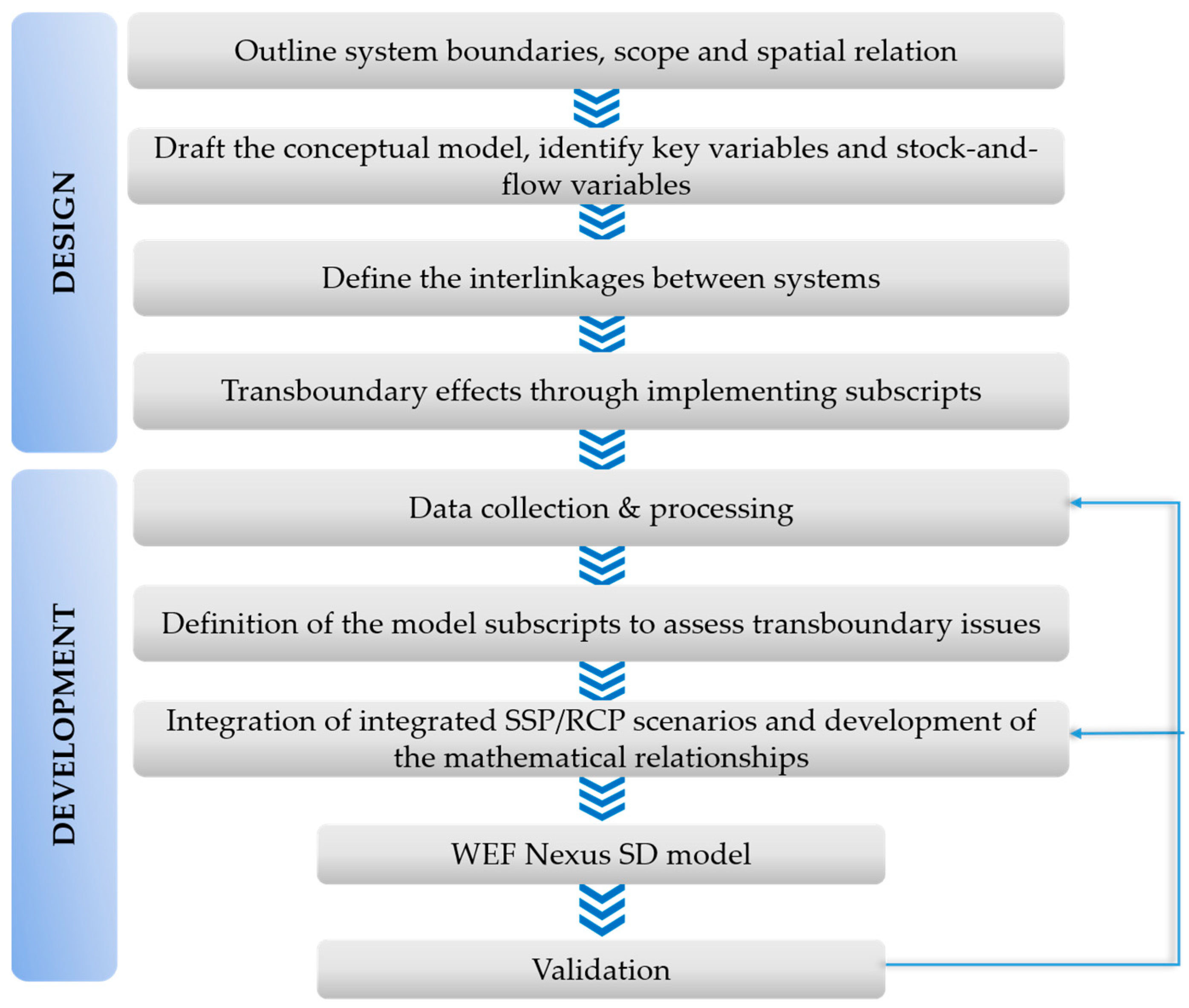
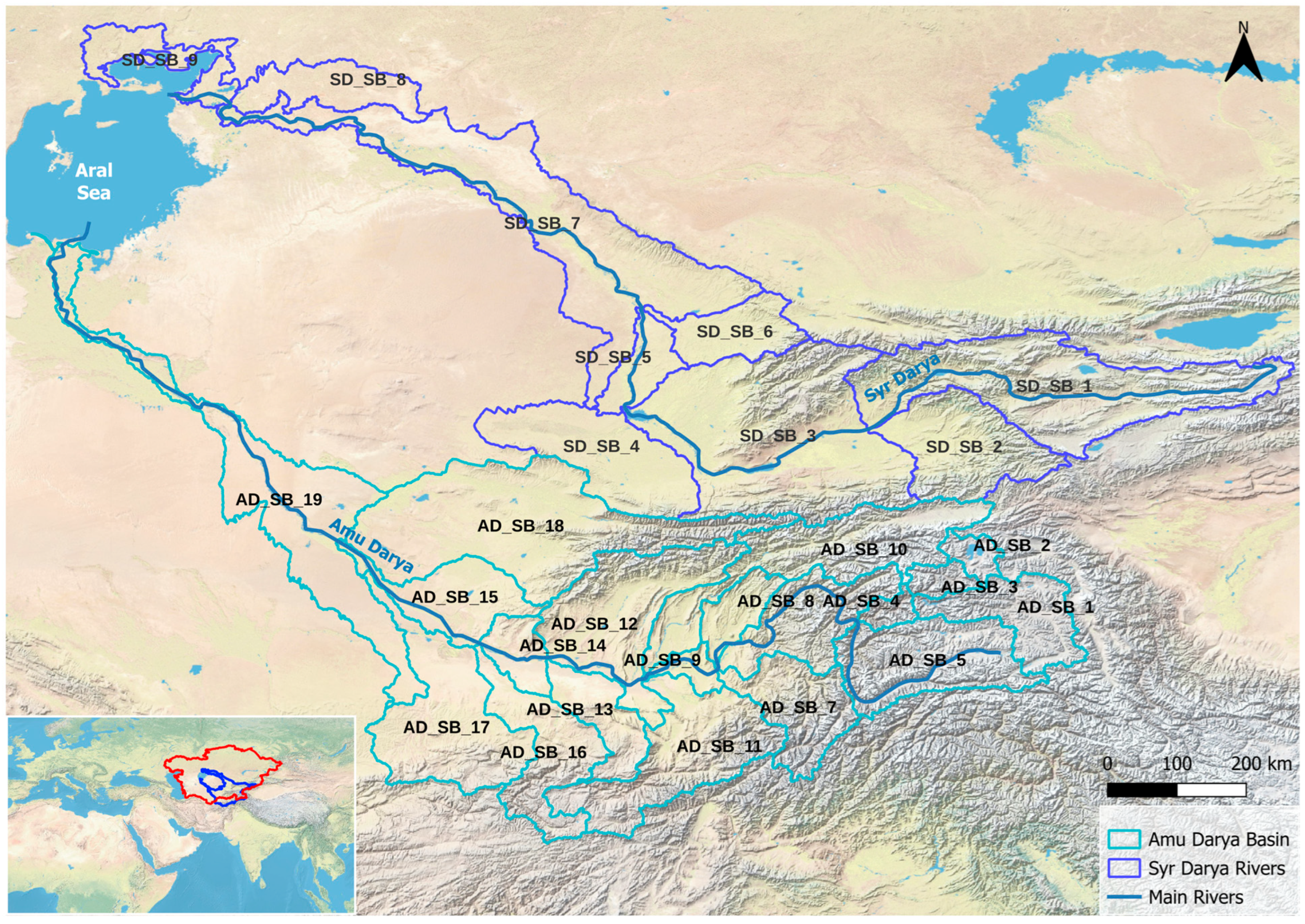

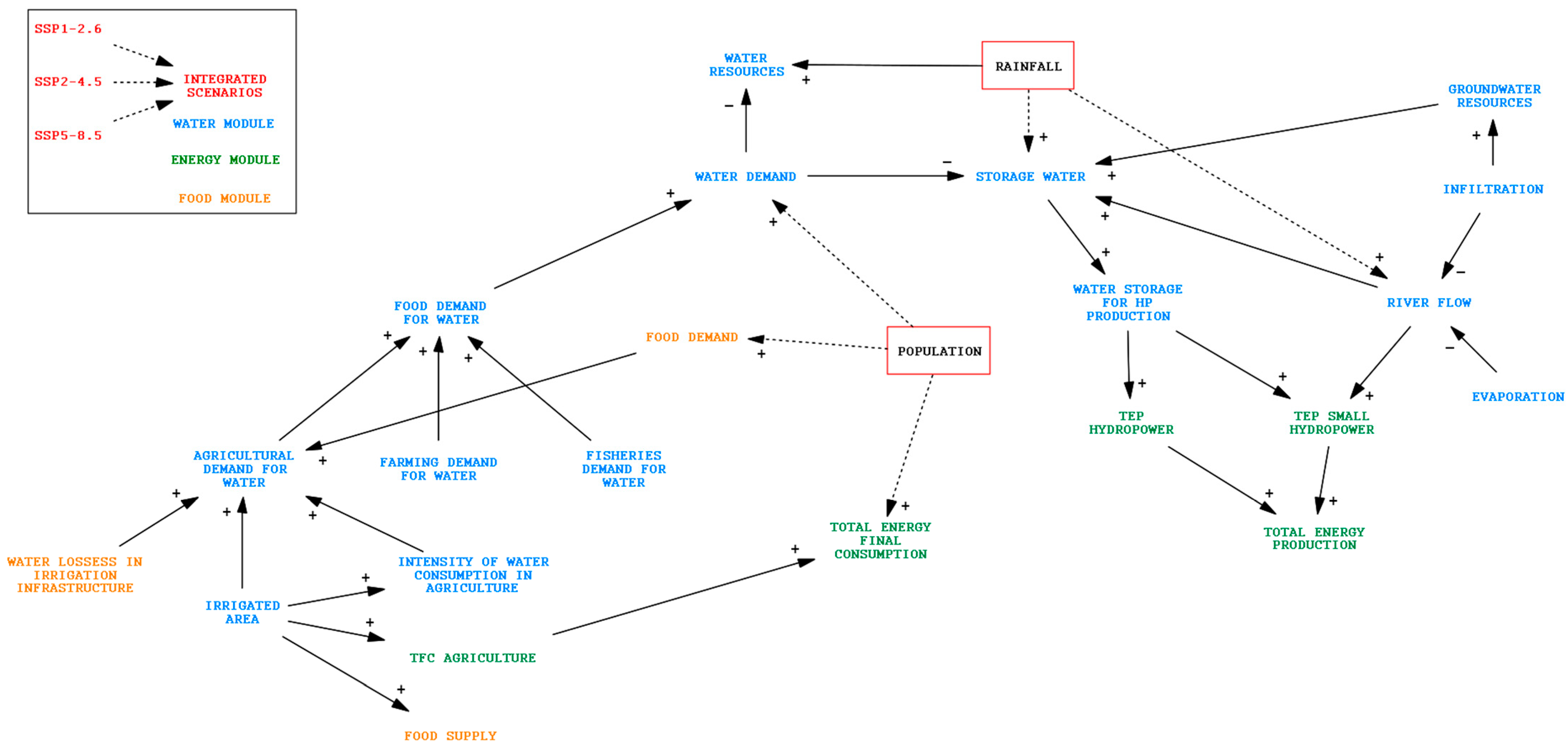


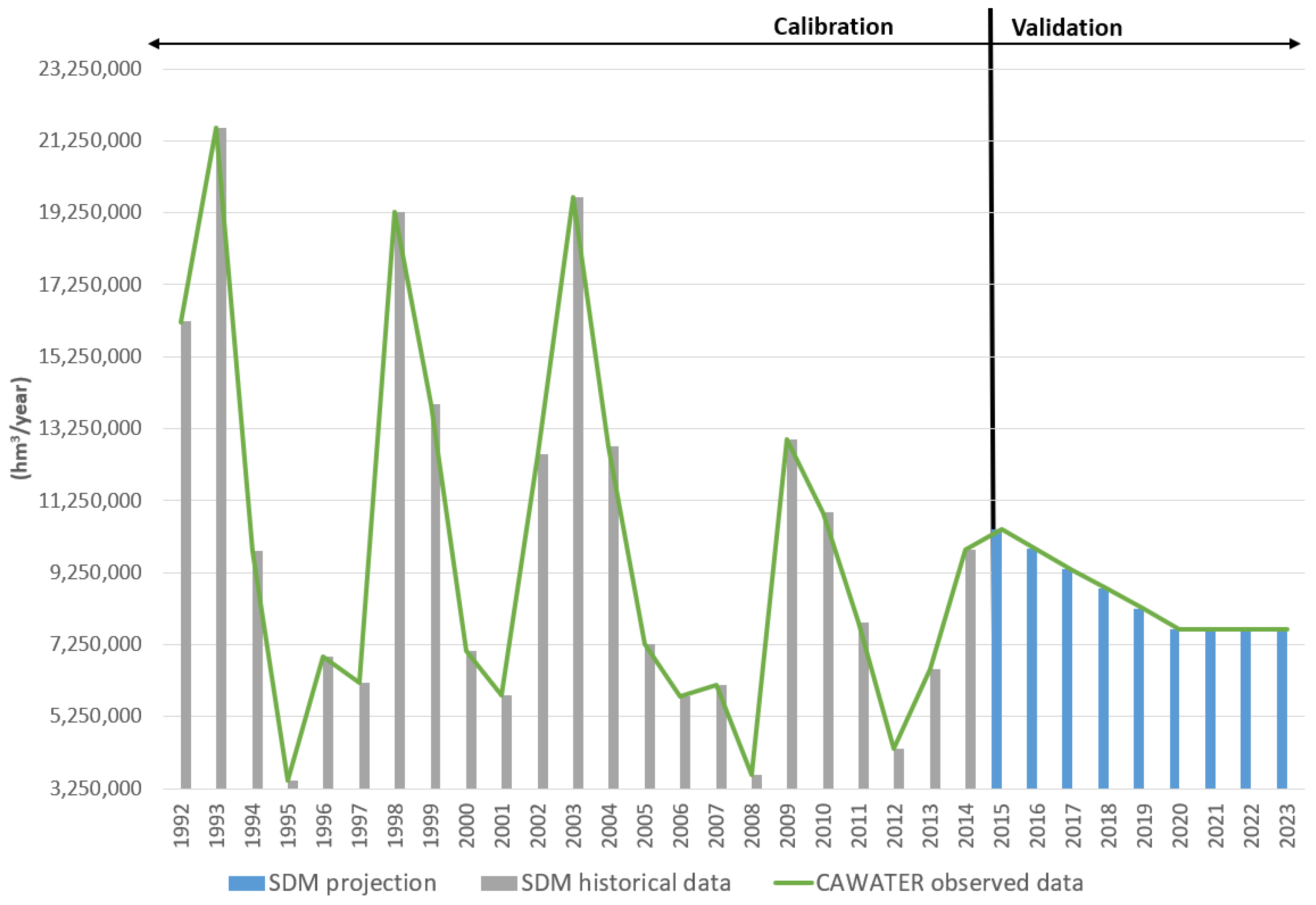
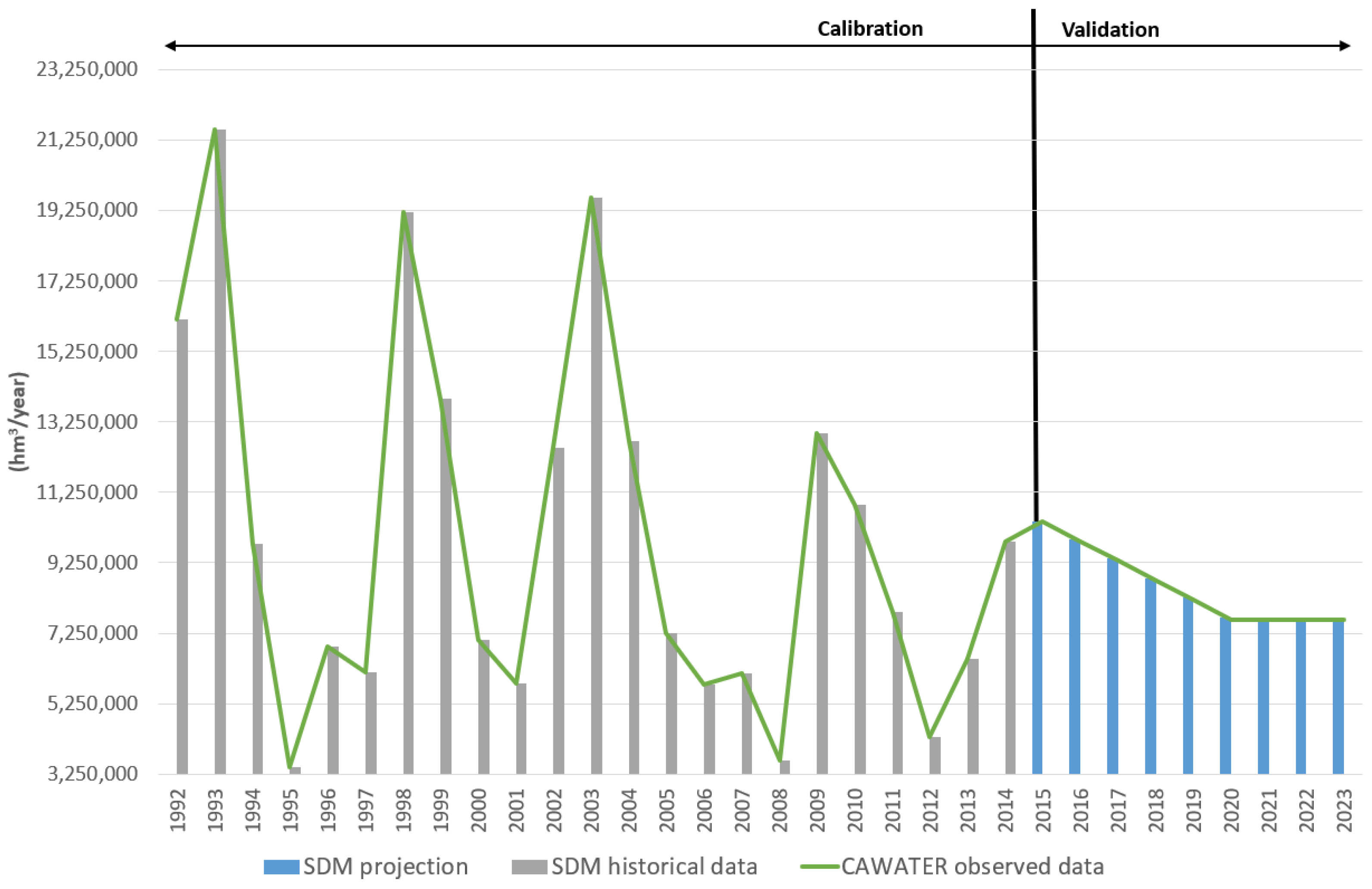

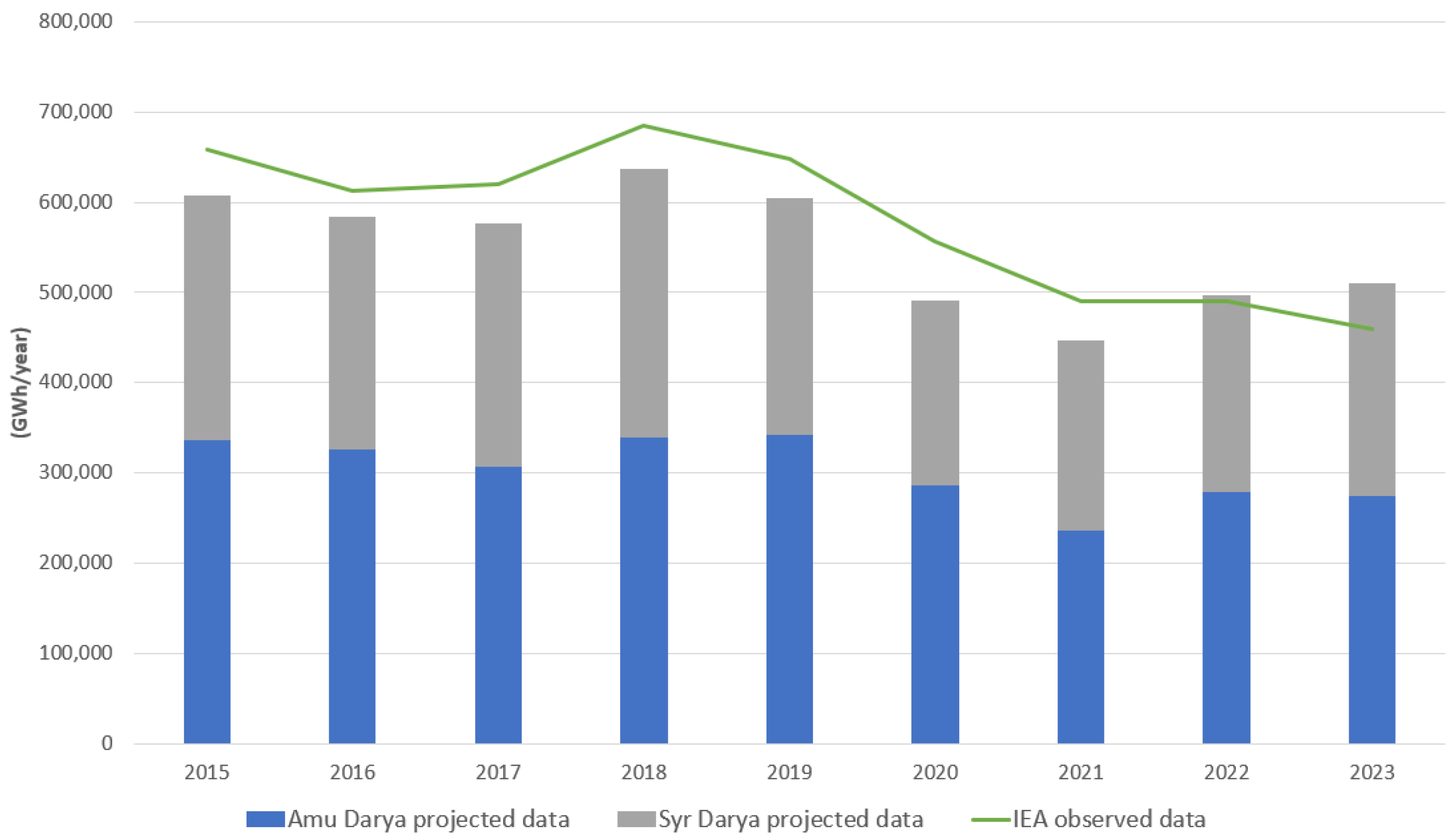
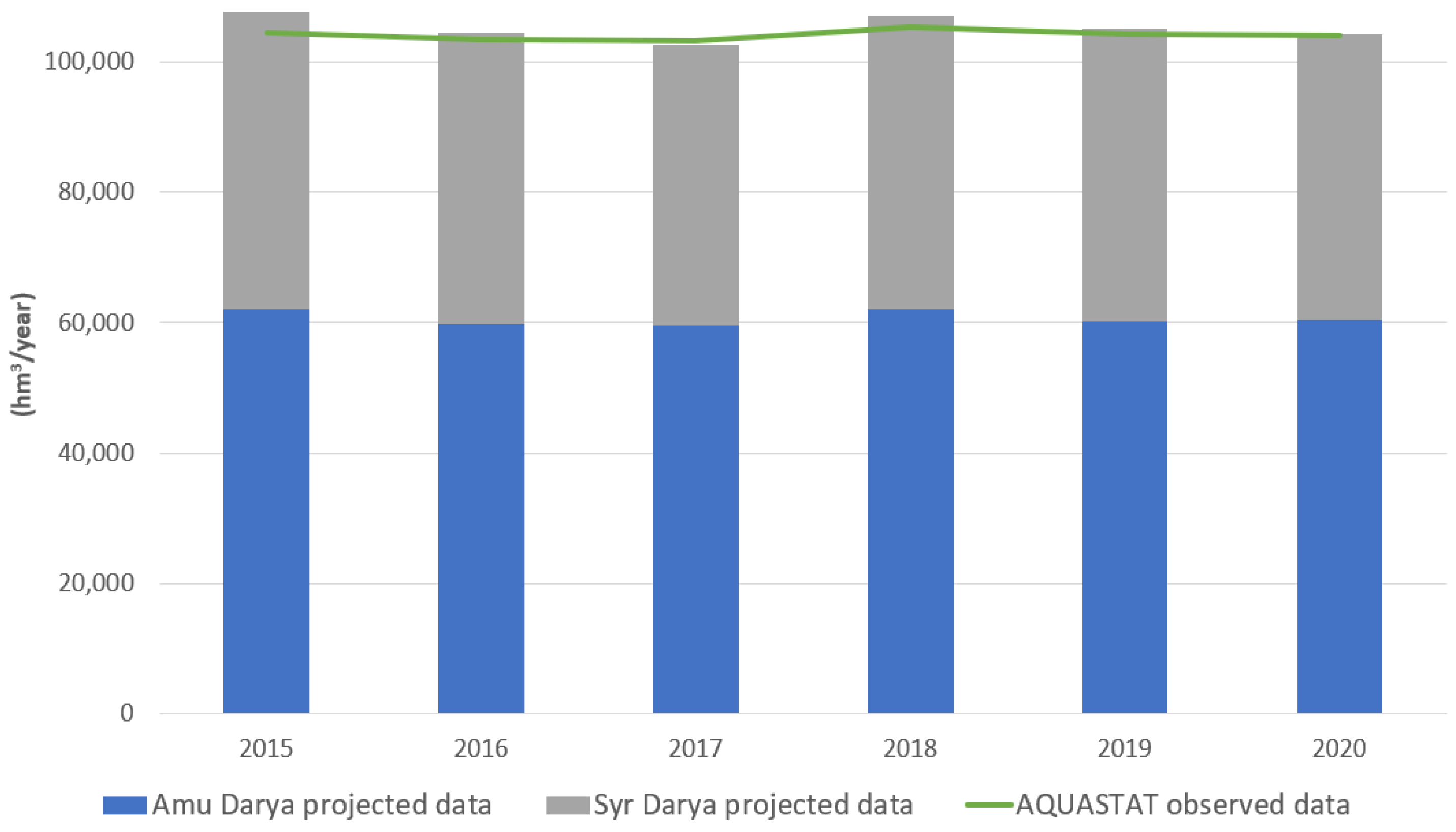
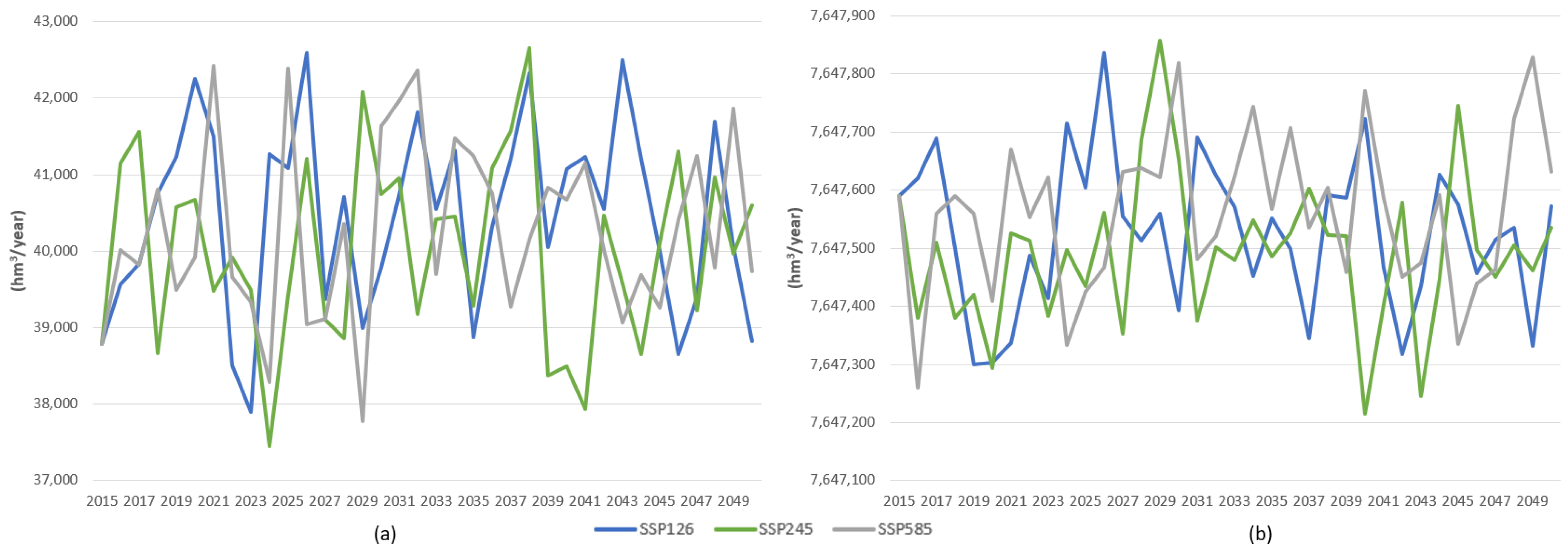
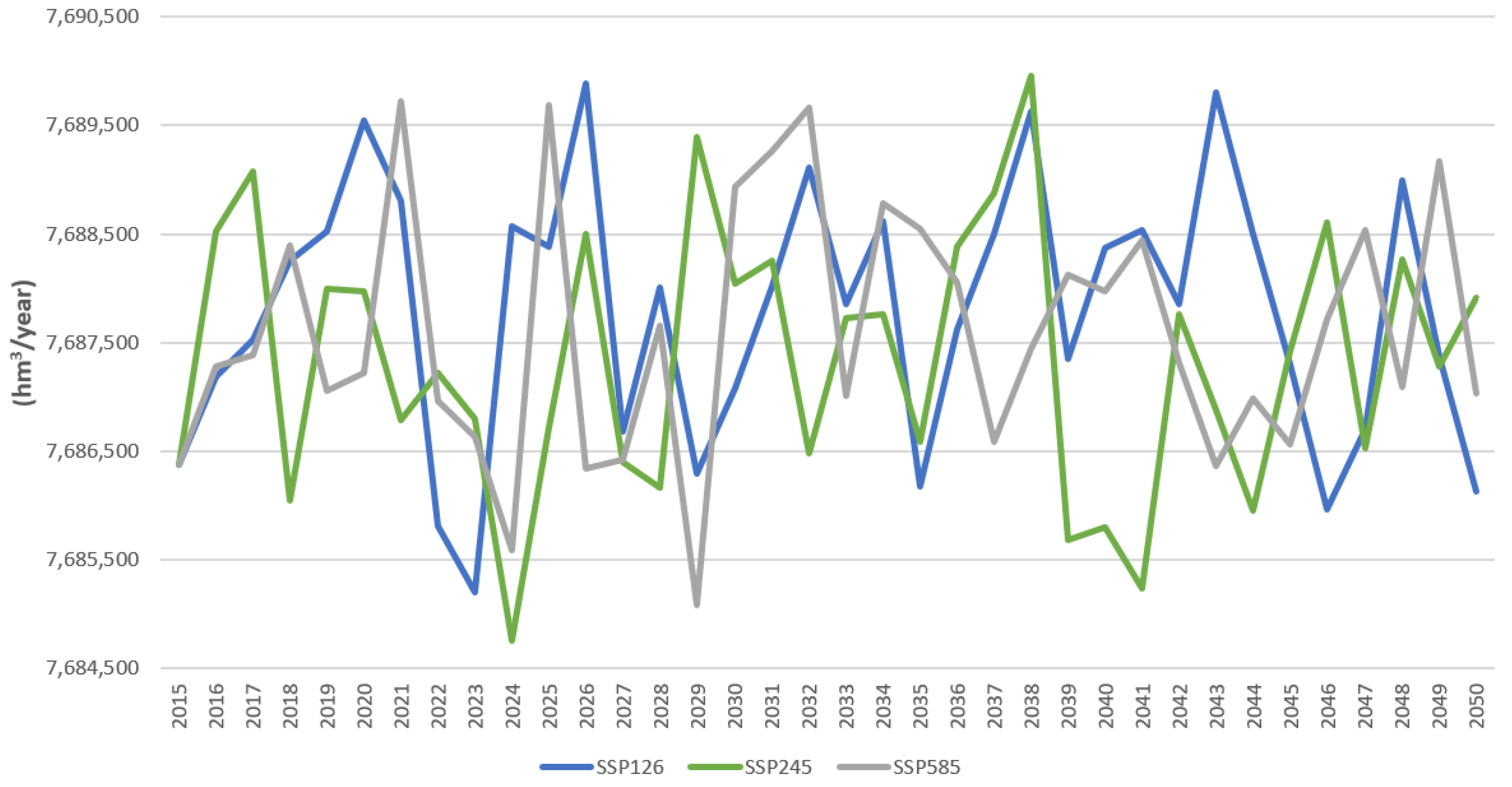

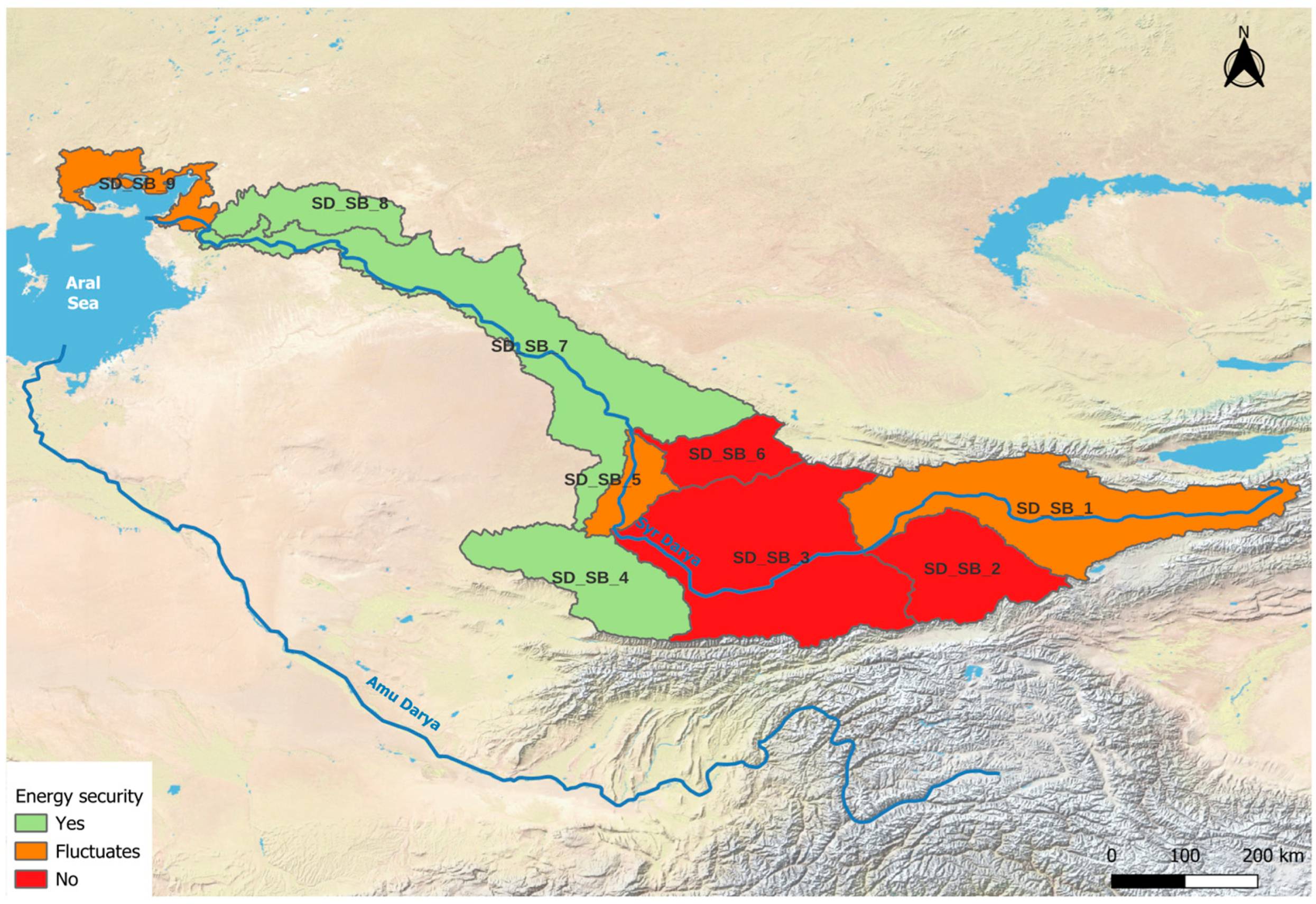
| Key Parameter * | Syr Darya | Amu Darya | Aral Sea Basin |
|---|---|---|---|
| Area (km2) [34] | 320,106 | 466,422 | 786,528 |
| Population (mill. inhab.) [35] | 26.86 | 30.51 | 57.37 |
| Rainfall (hm3) [36] | 202,307 | 284,284 | 486,591 |
| Per capita water consumption (hm3/inhab.) [37] | 1.32 × 10−3 | 1.39 × 10−3 | 1.36 × 10−3 |
| Per capita energy consumption (GWh/inhab.) [38]. | 4.0 | 1.8 | 2.9 |
| HP installed capacity (MW) [39] | 5097 | 5480 | 10,576 |
| SHP installed capacity (MW) [39] | 89 | 79 | 168 |
| HP sustainable and remaining capacity (MW) [40] | 11,718 | 16,412 | 28,130 |
| SHP sustainable and remaining capacity (MW) [40] | 910 | 1518 | 2428 |
| Rainfed area (km2) [41] | 27,676 | 28,440 | 56,115 |
| Irrigated area (km2) [41] | 31,443 | 42,317 | 73,760 |
| Subsystem | N. of Stock Variables | N. of Flow Variables | Rest of Variables |
|---|---|---|---|
| Water | 2 | 4 | 129 |
| Energy | 2 | 4 | 82 |
| Food | 1 | 2 | 73 |
| Others | - | - | 231 |
| Total | 5 | 10 | 515 |
Disclaimer/Publisher’s Note: The statements, opinions and data contained in all publications are solely those of the individual author(s) and contributor(s) and not of MDPI and/or the editor(s). MDPI and/or the editor(s) disclaim responsibility for any injury to people or property resulting from any ideas, methods, instructions or products referred to in the content. |
© 2025 by the authors. Licensee MDPI, Basel, Switzerland. This article is an open access article distributed under the terms and conditions of the Creative Commons Attribution (CC BY) license (https://creativecommons.org/licenses/by/4.0/).
Share and Cite
Pérez Pérez, S.; Ramos-Diez, I.; López Fernández, R. Transboundary Water–Energy–Food Nexus Management in Major Rivers of the Aral Sea Basin Through System Dynamics Modelling. Water 2025, 17, 2270. https://doi.org/10.3390/w17152270
Pérez Pérez S, Ramos-Diez I, López Fernández R. Transboundary Water–Energy–Food Nexus Management in Major Rivers of the Aral Sea Basin Through System Dynamics Modelling. Water. 2025; 17(15):2270. https://doi.org/10.3390/w17152270
Chicago/Turabian StylePérez Pérez, Sara, Iván Ramos-Diez, and Raquel López Fernández. 2025. "Transboundary Water–Energy–Food Nexus Management in Major Rivers of the Aral Sea Basin Through System Dynamics Modelling" Water 17, no. 15: 2270. https://doi.org/10.3390/w17152270
APA StylePérez Pérez, S., Ramos-Diez, I., & López Fernández, R. (2025). Transboundary Water–Energy–Food Nexus Management in Major Rivers of the Aral Sea Basin Through System Dynamics Modelling. Water, 17(15), 2270. https://doi.org/10.3390/w17152270






